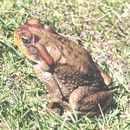Brief Summary
provided by IABIN
Diagnosis A medium-sized toad belonging to the Rhinella marina group possessing the following characteristics: (1) tibial glands absent; (2) elongated parotoid glands; (3) interorbital skin smooth; (4) ratio between the length of second digit of foot and the length of metacarpal tubercle; more than 1.63; and (5) cranial crests and parotoid glands reddish-brown.
- author
- Esteban O. Lavilla
- editor
- Diego Arrieta
Distribution
provided by IABIN
Northern Uruguay (Departments of Artigas, Cerro Largo, Rivera, Tacuarembó y Treinta y Tres) and southern and central Rio Grande do Sul state, Brazil.
- author
- Esteban O. Lavilla
- editor
- Diego Arrieta
Diagnostic Description
provided by IABIN
Description of holotype The holotype has a robust body; head short and indistinct from neck; interorbital region flat and smooth, without glands or rugosities; cephalic crests distinct; canthal, preorbital, supraorbital, and postorbital crests well developed, parietal crest present but poorly developed; snout short, slightly rounded in dorsal view and truncate in lateral view; nostrils visible, immediately below the tip of the canthal cephalic crest; eyelid length about 1.73 of eyelid height; eyeÂ?nostril distance about 2.43 of interorbital distance; canthus rostralis and loreal region slightly convex; tympanum distinct, rounded to ovoid; eyelid length about 2.53the vertical axis of tympanum; dorsal edge of tympanum concealed by postorbital cephalic crest; tongue lanceolate, width of posterior end about twice of anterior tip. Forelimb short and slender; hand with thick fingers having rows of small glands on both surfaces, more conspicuous in ventral view and particularly in Fingers III and IV. Relative length of fingers IV< II < I < III; webbing absent. The hand has two, rounded, palmar tubercles; outer one slightly larger. Subarticular tubercles distinct, round, simple or slightly bifid. Length of foot about 1.53of the length of the tibia. Relative length of toes I < II < V < III < IV. Tarsal fold present. Feet with two metatarsal tubercles of about equal size, but the inner metatarsal tubercle is taller than the outer one. Subarticular tubercles are present but less conspicuous than those on the digits of the hand. The feet have a well-developed interdigital membrane, reaching the distal tip of Toes I, II, and III and including most of Toe V. Interdigital membrane reaching only half of Toe IV (the longest toe). Skin on dorsum of body with numerous scattered glands; ventral skin smoother but uniformly covered with smaller glands that are more conspicuous in the chest and throat regions; lacking distinct dorsal glandular ridges, sometimes a poorly defined glandular ridge is visible posterior to the parotoid gland. Skin of dorsum with tubercles arranged in two series on both sides of the dorsal middle line, extending from behind the head to about half of the length of the body; on the posterior half, these tubercles are scattered randomly. The parotoid glands are elongate; their length is about 33their maximum anterior width and 1.53 of the orbital width. The posterior margin of the parotoid is rounded. Measurements of the holotype (in millimeters): snout-vent length 119.0; eyelid height 7.0; interparietal width 19.4; head width 43.9; eyelid length 12.6; eye-nostril distance 6.9; metacarpal tubercle 5.5; length of Finger II 9.5; head length 29.1, head width 43.9, internarinal distance 7.7, upper forearm 33.0, lower forearm 39.2, thigh length 50.6, leg length 5 47.4. Coloration: In life, coloration is uniformly brown. Parotoid glands and cephalic crests are distinctly reddish-brown. Ventrally, coloration is uniformly light to yellow brown. In preservative, overall coloration is gray to brown; edges of parotoids and of cephalic crests are darker brown maintaining their characteristic reddish tones Variation Juvenile individuals, less than 50 mm in snout-vent length, have several light cream or yellowish spots arranged in two parallel series on the dorsum.
- author
- Esteban O. Lavilla
- editor
- Diego Arrieta
Conservation Status
provided by IABIN
LC. Least Concern. Uruguayan populations are considered "en peligro" (endangered).
- author
- Esteban O. Lavilla
- editor
- Diego Arrieta
Rhinella achavali: Brief Summary
provided by wikipedia EN
Rhinella achavali is a species of toads in the family Bufonidae that is found in Uruguay and southernmost Brazil (Rio Grande do Sul).
Rhinella achavali are found in or near small forest streams. It is locally common but its habitat is threatened by plantations of exotic wood species.
- license
- cc-by-sa-3.0
- copyright
- Wikipedia authors and editors

